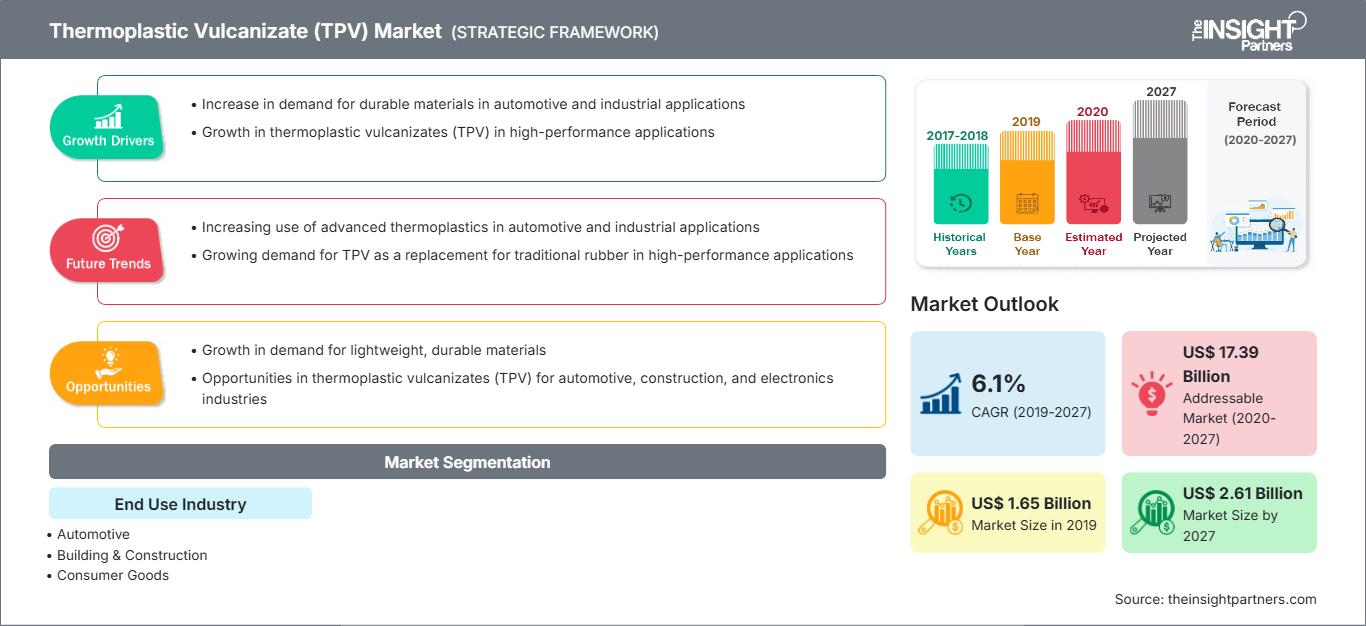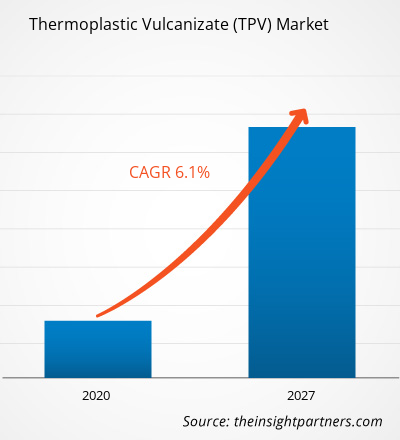Il mercato dei vulcanizzati termoplastici (TPV) è stato valutato a 1.646,78 milioni di dollari nel 2019 e si prevede che raggiungerà i 2.612,50 milioni di dollari entro il 2027; si prevede una crescita a un CAGR del 6,1% durante il periodo di previsione.
I vulcanizzati termoplastici sono utilizzati in un'ampia varietà di prodotti come lavatrici e asciugatrici, lavastoviglie, piccoli elettrodomestici, manopole e guarnizioni e frigoriferi, per parti rigide e guarnizioni. Si prevede che la domanda di vulcanizzati termoplastici nel settore dei beni di consumo aumenterà grazie ai vantaggi di materiali leggeri, versatili e morbidi in diverse aree di applicazione, tra cui abbigliamento, elettrodomestici, prodotti per la cura della persona, utensili da cucina ed elettroutensili. Inoltre, si prevede che la crescita dell'industria dei beni di consumo nei paesi BRIC avrà un impatto positivo sul mercato dei vulcanizzati termoplastici. I vulcanizzati termoplastici (TPV) offrono un'eccellente efficienza, costi di sistema ridotti e potenziale sostenibilità. Grazie a questi vantaggi, i TPV vengono utilizzati nel settore dei beni di consumo. Ad esempio, ExxonMobil Chemical produce vulcanizzati termoplastici (TPV) con elastomeri ad alte prestazioni che offrono versatilità di produzione, facilità di lavorazione e durata. Offrendo prestazioni superiori e costanti in applicazioni industriali e di consumo complesse, i TPV offrono il potenziale per ridurre i costi dei dispositivi, il peso ridotto e la riciclabilità rispetto a materiali come l'EPDM (struttura portante in etilene propilene diene polimetilene) o altre gomme termoindurenti.
Si prevede che il Nord America deterrà la quota maggiore del mercato globale dei vulcanizzati termoplastici (TPV) durante il periodo di previsione. Diverse aziende nazionali e internazionali hanno una solida presenza nella regione nordamericana. La crescita del mercato dei vulcanizzati termoplastici (TPV) in questa regione è principalmente attribuibile alla crescente domanda di materiali leggeri per la produzione di diversi componenti per auto. Inoltre, si prevede che le normative governative favorevoli relative al consumo di TPV nelle applicazioni automobilistiche come alternativa a leghe e metalli, insieme all'aumento della produzione di autovetture negli Stati Uniti e in Messico, alimenteranno ulteriormente la crescita del mercato regionale nel periodo di previsione. Inoltre, gli sviluppi tecnici e la crescente domanda di veicoli elettrici hanno aumentato la necessità di prodotti leggeri, robusti e riciclabili, che a loro volta hanno spinto la crescita del mercato.
Stati Uniti, India, Brasile, Russia, Francia, Regno Unito, Turchia, Italia e Spagna sono tra i paesi più colpiti in termini di casi confermati e decessi segnalati a causa di COVID-19, a dicembre 2020. Secondo i dati dell'OMS a dicembre 2020, nel mondo sono stati segnalati circa 80.453.105 casi confermati e 1.775.776 decessi. La pandemia di COVID-19 ha colpito le economie a causa di lockdown, divieti di viaggio e chiusure aziendali. L'industria chimica e dei materiali a livello globale è una delle principali aziende che subisce interruzioni della catena di approvvigionamento e interruzioni della produzione a causa di queste restrizioni. La Cina è il polo manifatturiero globale e il principale fornitore di materie prime per diversi settori. Il blocco di vari stabilimenti e fabbriche in regioni chiave, come l'Asia-Pacifico e l'Europa, sta influenzando le catene di approvvigionamento globali e incidendo negativamente sulla produzione, sui tempi di consegna e sulle vendite dei prodotti. Questi fattori hanno influito negativamente sulla crescita del mercato globale dei vulcanizzati termoplastici (TPV).
Personalizza questo rapporto in base alle tue esigenze
Potrai personalizzare gratuitamente qualsiasi rapporto, comprese parti di questo rapporto, o analisi a livello di paese, pacchetto dati Excel, oltre a usufruire di grandi offerte e sconti per start-up e università
Mercato dei vulcanizzati termoplastici (TPV): Approfondimenti strategici

-
Ottieni le principali tendenze chiave del mercato di questo rapporto.Questo campione GRATUITO includerà l'analisi dei dati, che vanno dalle tendenze di mercato alle stime e alle previsioni.
Per ridurre al minimo la dipendenza da risorse non rinnovabili, come il petrolio, e per raggiungere uno sviluppo sostenibile del settore dei materiali polimerici, un gran numero di persone preferisce i materiali polimerici di origine biologica. I vulcanizzati termoplastici di origine biologica (TPV) sono realizzati in polilattide (PLA) e gomma etilene-co-vinil acetato (EVA) fabbricati utilizzando il perossido di dicumile (DCP) come agente di vulcanizzazione; è la prima volta che viene dimostrata l'applicazione del PLA nei materiali elastici. Poiché i TPV di origine biologica contengono basse emissioni di carbonio e sono biodegradabili in natura, la loro sintesi è incoraggiata nella maggior parte dei paesi. Sono attualmente considerati alternative sostenibili ai tradizionali polimeri derivati dal petrolio, poiché derivano da risorse rinnovabili come polimeri a base di amido, polilattidi (PLA), poliidrossialcanoati (PHA), polimeri a base di cellulosa e polimeri a base di soia. Poiché i TPE di origine biologica non solo forniscono una soluzione pulita, ma offrono anche ai produttori di TPE di origine biologica una competitività di costo rispetto alle loro controparti sintetiche, si prevede che creeranno significative opportunità di crescita del mercato.
Approfondimenti sul settore di utilizzo finale
In base al settore di utilizzo finale, il mercato dei materiali termoplastici vulcanizzati (TPV) è segmentato in automotive, edilizia e costruzioni, beni di consumo, sanità e altri. Nel 2019, il segmento automotive ha dominato il mercato. I materiali leggeri per autoveicoli hanno registrato una forte crescita negli ultimi anni a causa della crescente domanda di veicoli di lusso, a basse emissioni, sicuri e ad alte prestazioni. Di conseguenza, fornitori e produttori hanno lanciato una serie di soluzioni che non solo aiutano gli OEM a rispettare le severe normative, ma soddisfano anche la crescente gamma di esigenze personali dei clienti. I TPV rappresentano anche un'alternativa ragionevole ai costosi elastomeri. Offrono un'eccellente durabilità elastomerica, tra cui una resistenza alla trazione e un allungamento a rottura relativamente elevati, un elevato recupero elastico, nonché una buona stabilità dimensionale in aria calda e un'eccellente resistenza all'invecchiamento da raggi UV, all'ozono e agli agenti atmosferici. Le principali applicazioni del TVP nell'industria automobilistica includono coperture per tubi flessibili, coperture per condotti di aspirazione dell'aria, guarnizioni, tenute, soffietti, smorzatori di vibrazioni, coperture per montanti, componenti di accensione, boccole e guarnizioni per finestrini. I componenti sottocofano in TPV flessibile per autoveicoli includono tubi e soffietti di aspirazione dell'aria, svasature del passaruota, soffietti del sistema sterzante e componenti per l'insonorizzazione. Inoltre, il costo dei TPV è considerato inferiore del 10-30% rispetto all'EPDM, combinato con un peso inferiore, una maggiore versatilità di progettazione e riciclabilità.
Mitsui Chemicals Inc., Celanese Corporation, Mitsubishi Chemical Corporation, Kumho Polychem, Trinseo, Teknor Apex, ExxonMobil, Zeon Chemicals LP, Alphagary e Ravago sono tra i principali attori presenti nel mercato globale del vulcanizzato termoplastico (TPV). Queste aziende stanno implementando lo sviluppo di nuovi prodotti e strategie di fusione e acquisizione per ampliare la propria clientela e acquisire una quota di mercato significativa nel mercato globale, il che, a sua volta, consente loro di mantenere il proprio marchio.
In evidenza nel rapporto
- Tendenze progressive del settore nel mercato globale del termoplastico vulcanizzato (TPV) che aiutano gli operatori a sviluppare strategie efficaci a lungo termine
- Strategie di crescita aziendale adottate dai mercati sviluppati e in via di sviluppo
- Analisi quantitativa del mercato globale del termoplastico vulcanizzato (TPV) dal 2017 al 2027
- Stima della domanda globale di termoplastico vulcanizzato (TPV) in vari settori
- Analisi PEST per illustrare l'efficacia di acquirenti e fornitori che operano nel settore
- Sviluppi recenti per comprendere lo scenario competitivo del mercato e la domanda globale di termoplastico vulcanizzato (TPV)
- Tendenze e prospettive di mercato e fattori che guidano e frenano la crescita del termoplastico vulcanizzato (TPV) globale mercato
- Comprendere le strategie che sostengono l'interesse commerciale in relazione alla crescita del mercato
- Dimensioni del mercato globale del vulcanizzato termoplastico (TPV) in vari nodi del mercato
- Panoramica dettagliata e segmentazione del mercato, nonché dinamiche del settore
- Dimensioni del mercato globale del vulcanizzato termoplastico (TPV) in varie regioni con promettenti opportunità di crescita nelle rispettive regioni
Approfondimenti regionali sul mercato dei vulcanizzati termoplastici (TPV)
Le tendenze regionali e i fattori che influenzano il mercato dei vulcanizzati termoplastici (TPV) durante il periodo di previsione sono stati ampiamente spiegati dagli analisti di The Insight Partners. Questa sezione illustra anche i segmenti e la geografia del mercato dei vulcanizzati termoplastici (TPV) in Nord America, Europa, Asia-Pacifico, Medio Oriente e Africa, America meridionale e centrale.
Ambito del rapporto di mercato sui vulcanizzati termoplastici (TPV)
| Attributo del rapporto | Dettagli |
|---|---|
| Dimensioni del mercato in 2019 | US$ 1.65 Billion |
| Dimensioni del mercato per 2027 | US$ 2.61 Billion |
| CAGR globale (2019 - 2027) | 6.1% |
| Dati storici | 2017-2018 |
| Periodo di previsione | 2020-2027 |
| Segmenti coperti |
By Settore di utilizzo finale
|
| Regioni e paesi coperti |
Nord America
|
| Leader di mercato e profili aziendali chiave |
|
Densità degli operatori del mercato dei vulcanizzati termoplastici (TPV): comprendere il suo impatto sulle dinamiche aziendali
Il mercato dei vulcanizzati termoplastici (TPV) è in rapida crescita, trainato dalla crescente domanda degli utenti finali, dovuta a fattori quali l'evoluzione delle preferenze dei consumatori, i progressi tecnologici e una maggiore consapevolezza dei vantaggi del prodotto. Con l'aumento della domanda, le aziende stanno ampliando la propria offerta, innovando per soddisfare le esigenze dei consumatori e sfruttando le tendenze emergenti, alimentando ulteriormente la crescita del mercato.

- Ottieni il Mercato dei vulcanizzati termoplastici (TPV) Panoramica dei principali attori chiave
- Automotive
- Edilizia e costruzioni
- Beni di consumo
- Sanità
- Altri
Profili aziendali
- Mitsui Chemicals Inc.
- Celanese Corporation
- Mitsubishi Chemical Corporation
- Kumho Polychem
- Trinseo
- Teknor Apex
- ExxonMobil
- Zeon Chemicals LP
- Alphagary
- Ravago
- Analisi storica (2 anni), anno base, previsione (7 anni) con CAGR
- Analisi PEST e SWOT
- Valore/volume delle dimensioni del mercato - Globale, Regionale, Nazionale
- Industria e panorama competitivo
- Set di dati Excel
Report recenti
Testimonianze
Motivo dell'acquisto
- Processo decisionale informato
- Comprensione delle dinamiche di mercato
- Analisi competitiva
- Analisi dei clienti
- Previsioni di mercato
- Mitigazione del rischio
- Pianificazione strategica
- Giustificazione degli investimenti
- Identificazione dei mercati emergenti
- Miglioramento delle strategie di marketing
- Aumento dell'efficienza operativa
- Allineamento alle tendenze normative






















 Ottieni un campione gratuito per - Mercato dei vulcanizzati termoplastici (TPV)
Ottieni un campione gratuito per - Mercato dei vulcanizzati termoplastici (TPV)